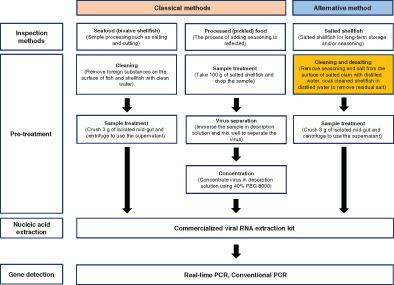当前位置:
X-MOL 学术
›
J. Food Saf.
›
论文详情
Our official English website, www.x-mol.net, welcomes your
feedback! (Note: you will need to create a separate account there.)
Evaluation of a test method to detect hepatitis A virus in salted shellfish
Journal of Food Safety ( IF 1.9 ) Pub Date : 2021-01-24 , DOI: 10.1111/jfs.12883 Deog‐Yong Lee 1 , Seung‐Rye Cho 1 , Su‐Jin Chae 1 , Wooyoung Choi 1 , Myung‐Guk Han 1
Journal of Food Safety ( IF 1.9 ) Pub Date : 2021-01-24 , DOI: 10.1111/jfs.12883 Deog‐Yong Lee 1 , Seung‐Rye Cho 1 , Su‐Jin Chae 1 , Wooyoung Choi 1 , Myung‐Guk Han 1
Affiliation

|
Contaminated salted shellfish were a suspected cause of the 2019 hepatitis A outbreak in Korea; however, no virus was detected in the shellfish by the virus detection tests used. In this study, we investigated the shortcomings of these detection tests for identifying hepatitis A virus in salted shellfish to serve as a guide for improvement of these tests. Salted shellfish were washed and desalted before collecting the mid‐guts for testing. For verification of the method, the mid‐guts were first inoculated with norovirus and then RT‐qPCR was performed to determine the presence of norovirus genes. The norovirus gene was amplified normally along with an internal positive control; however, when the nucleic acid was extracted to be concentrated, gene amplification was inhibited. Since NaCl was the suspected contaminant, RT‐qPCR was then performed on samples that had been desalinated for 2 days, and hepatitis A virus genes were successfully detected. Gene amplification enabled analyzing the relationship between patients in the outbreak and the distributed salted shellfish. To detect viral contamination in salted and fermented specimens such as salted shellfish, it is imperative to extract the mid‐gut intestinal tract and remove any PCR inhibitors (e.g., excess salt). In this study, desalting salted shellfish using sterile distilled water before harvesting the mid‐gut was effective in facilitating hepatitis A detection. Development of future test methods requires accurately determining the effect of PCR inhibitors through the incorporation of an IPC in genetic detection tests.
中文翻译:

评价咸贝类中甲型肝炎病毒检测方法的评价
盐渍贝类污染是韩国2019年甲型肝炎暴发的可疑原因; 但是,通过使用的病毒检测测试,在贝类中未检测到病毒。在这项研究中,我们调查了在盐腌贝类中鉴定甲型肝炎病毒的这些检测方法的缺点,以作为改进这些检测方法的指南。在收集中肠进行测试之前,先将盐渍的贝类洗净并脱盐。为了验证该方法,首先用诺如病毒接种中肠,然后进行RT-qPCR以确定诺如病毒基因的存在。诺如病毒基因与内部阳性对照一起正常扩增。但是,将核酸提取浓缩后,基因扩增受到抑制。由于氯化钠是可疑污染物,然后对已脱盐2天的样品进行RT-qPCR,成功检测出甲型肝炎病毒基因。基因扩增可以分析暴发患者与盐腌贝类之间的关系。为了检测盐渍和发酵标本(例如盐渍贝类)中的病毒污染,必须提取肠道中段的肠道并去除任何PCR抑制剂(例如过量的盐)。在这项研究中,在收获中肠之前使用无菌蒸馏水对咸贝进行脱盐可有效地促进甲型肝炎的检测。未来测试方法的发展要求通过在基因检测测试中加入IPC来准确确定PCR抑制剂的作用。成功检测出甲型肝炎病毒基因。基因扩增可以分析暴发患者与盐腌贝类之间的关系。为了检测盐渍和发酵标本(例如盐渍贝类)中的病毒污染,必须提取肠道中段的肠道并去除任何PCR抑制剂(例如过量的盐)。在这项研究中,在收获中肠之前使用无菌蒸馏水对咸贝进行脱盐可有效地促进甲型肝炎的检测。未来测试方法的发展要求通过在基因检测测试中加入IPC来准确确定PCR抑制剂的作用。成功检测出甲型肝炎病毒基因。基因扩增可以分析暴发患者与盐腌贝类之间的关系。为了检测盐渍和发酵标本(例如盐渍贝类)中的病毒污染,必须提取肠道中段的肠道并去除任何PCR抑制剂(例如过量的盐)。在这项研究中,在收获中肠之前使用无菌蒸馏水对咸贝进行脱盐可有效地促进甲型肝炎的检测。未来测试方法的发展要求通过在基因检测测试中加入IPC来准确确定PCR抑制剂的作用。为了检测盐渍和发酵标本(例如盐渍贝类)中的病毒污染,必须提取肠道中段的肠道并去除任何PCR抑制剂(例如过量的盐)。在这项研究中,在收获中肠之前使用无菌蒸馏水对咸贝进行脱盐可有效地促进甲型肝炎的检测。未来测试方法的发展要求通过在基因检测测试中加入IPC来准确确定PCR抑制剂的作用。为了检测盐渍和发酵标本(例如盐渍贝类)中的病毒污染,必须提取肠道中段的肠道并去除任何PCR抑制剂(例如过量的盐)。在这项研究中,在收获中肠之前使用无菌蒸馏水对咸贝进行脱盐可有效地促进甲型肝炎的检测。未来测试方法的发展要求通过在基因检测测试中加入IPC来准确确定PCR抑制剂的作用。
更新日期:2021-01-24
中文翻译:

评价咸贝类中甲型肝炎病毒检测方法的评价
盐渍贝类污染是韩国2019年甲型肝炎暴发的可疑原因; 但是,通过使用的病毒检测测试,在贝类中未检测到病毒。在这项研究中,我们调查了在盐腌贝类中鉴定甲型肝炎病毒的这些检测方法的缺点,以作为改进这些检测方法的指南。在收集中肠进行测试之前,先将盐渍的贝类洗净并脱盐。为了验证该方法,首先用诺如病毒接种中肠,然后进行RT-qPCR以确定诺如病毒基因的存在。诺如病毒基因与内部阳性对照一起正常扩增。但是,将核酸提取浓缩后,基因扩增受到抑制。由于氯化钠是可疑污染物,然后对已脱盐2天的样品进行RT-qPCR,成功检测出甲型肝炎病毒基因。基因扩增可以分析暴发患者与盐腌贝类之间的关系。为了检测盐渍和发酵标本(例如盐渍贝类)中的病毒污染,必须提取肠道中段的肠道并去除任何PCR抑制剂(例如过量的盐)。在这项研究中,在收获中肠之前使用无菌蒸馏水对咸贝进行脱盐可有效地促进甲型肝炎的检测。未来测试方法的发展要求通过在基因检测测试中加入IPC来准确确定PCR抑制剂的作用。成功检测出甲型肝炎病毒基因。基因扩增可以分析暴发患者与盐腌贝类之间的关系。为了检测盐渍和发酵标本(例如盐渍贝类)中的病毒污染,必须提取肠道中段的肠道并去除任何PCR抑制剂(例如过量的盐)。在这项研究中,在收获中肠之前使用无菌蒸馏水对咸贝进行脱盐可有效地促进甲型肝炎的检测。未来测试方法的发展要求通过在基因检测测试中加入IPC来准确确定PCR抑制剂的作用。成功检测出甲型肝炎病毒基因。基因扩增可以分析暴发患者与盐腌贝类之间的关系。为了检测盐渍和发酵标本(例如盐渍贝类)中的病毒污染,必须提取肠道中段的肠道并去除任何PCR抑制剂(例如过量的盐)。在这项研究中,在收获中肠之前使用无菌蒸馏水对咸贝进行脱盐可有效地促进甲型肝炎的检测。未来测试方法的发展要求通过在基因检测测试中加入IPC来准确确定PCR抑制剂的作用。为了检测盐渍和发酵标本(例如盐渍贝类)中的病毒污染,必须提取肠道中段的肠道并去除任何PCR抑制剂(例如过量的盐)。在这项研究中,在收获中肠之前使用无菌蒸馏水对咸贝进行脱盐可有效地促进甲型肝炎的检测。未来测试方法的发展要求通过在基因检测测试中加入IPC来准确确定PCR抑制剂的作用。为了检测盐渍和发酵标本(例如盐渍贝类)中的病毒污染,必须提取肠道中段的肠道并去除任何PCR抑制剂(例如过量的盐)。在这项研究中,在收获中肠之前使用无菌蒸馏水对咸贝进行脱盐可有效地促进甲型肝炎的检测。未来测试方法的发展要求通过在基因检测测试中加入IPC来准确确定PCR抑制剂的作用。











































 京公网安备 11010802027423号
京公网安备 11010802027423号